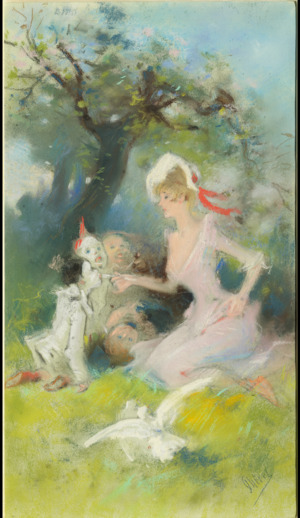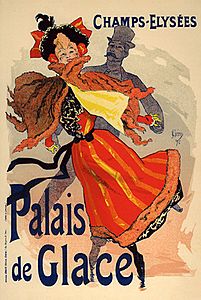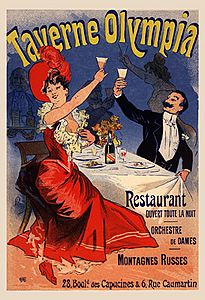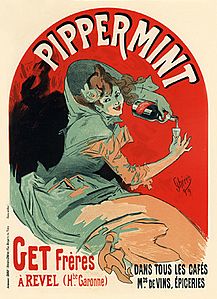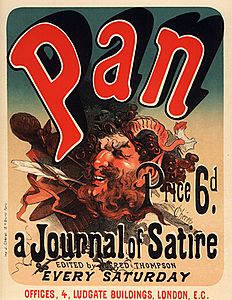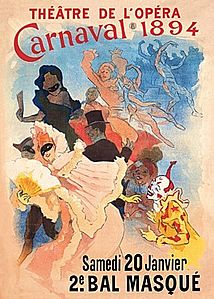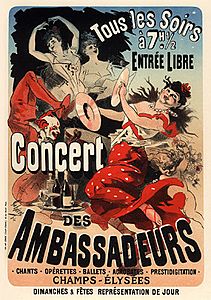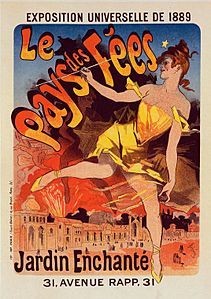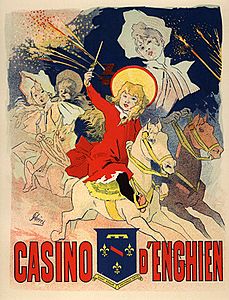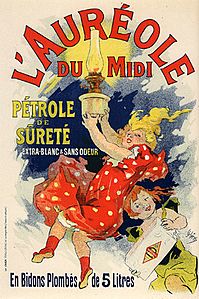Jules Chéret facts for kids
Quick facts for kids
Jules Chéret
|
|
|---|---|
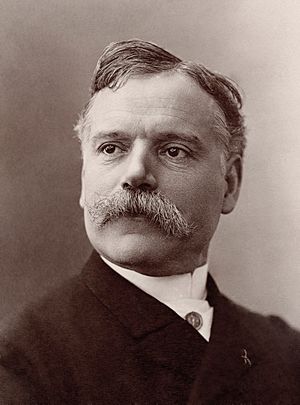
Jules Chéret photographed by Nadar, c. 1900
|
|
| Born |
Jules Chéret
31 May 1836 Paris, France
|
| Died | 23 September 1932 (aged 96) Nice, France
|
| Nationality | French |
| Education | École Nationale de Dessin |
| Known for | Lithography, Poster art |
| Movement | Art Nouveau |
| Awards | Légion d'honneur |
Jules Chéret (born May 31, 1836 – died September 23, 1932) was a French painter. He was also a master of lithography, a special way of making prints. Chéret became famous for his amazing posters during the Belle Époque (a beautiful time in French history). Many people call him the father of the modern poster.
Contents
Early Life and Art Career
Jules Chéret was born in Paris, France. His family didn't have much money, but they were very creative. Jules didn't get much schooling. When he was 13, he started learning how to make prints using lithography. This training lasted for three years.
Later, he became very interested in painting. He took art classes at a school called the École Nationale de Dessin. Like many young artists, Chéret visited museums in Paris. He studied the techniques of famous artists from the past and present.
From 1859 to 1866, he continued his lithography training in London, England. There, he learned a lot from how British artists designed and printed posters. When he returned to France, Chéret started making bright and lively posters. These posters advertised fun places like cabarets, music halls, and theaters. Some famous places he made posters for include the Folies Bergère and the Moulin Rouge. He also created illustrations for a funny weekly newspaper called Le Courrier français.
Jules Chéret was one of the first artists to create illustrated posters. He worked with two brothers, Léon and Alfred Choubrac. In the early 1870s, they made important improvements. These changes helped to make color lithography cheaper to produce.
How His Posters Became Popular
Chéret's artworks were inspired by the fun and lively scenes. These were often seen in paintings by Rococo artists like Jean-Honoré Fragonard. People loved his posters so much that his business grew. He started making advertisements for traveling theater groups and city festivals.
Soon, he was creating ads for drinks, perfumes, soaps, and other products. He became a major force in advertising. Even railroad companies and big factories wanted him to design their ads.
As his work became more popular, his large posters showed women who looked free-spirited and happy. People started calling him the "father of women's liberation." The women in Chéret's posters were joyful, elegant, and full of life. People called them 'Cherettes'. These posters showed a more open Paris. Women in Paris could now enjoy activities that were once considered unusual. This included wearing low-cut dresses and smoking in public. These 'Cherettes' were seen everywhere and were very well-known. One writer at the time said it was hard to imagine Paris without Chéret's posters.
In 1895, Chéret started the Maîtres de l'Affiche collection. This was an important art publication. It featured smaller copies of the best works by 97 Parisian artists. His success inspired many new poster designers and painters. These included artists like Henri de Toulouse-Lautrec. One of his students was Georges de Feure.
When he was older, Chéret moved to the sunny French Riviera in Nice. He passed away in 1932 at 96 years old. He was buried in the Cimetière Saint-Vincent in Paris.
His Lasting Impact
The French Government honored Jules Chéret in 1890. They gave him the Légion d'honneur award. This was for his amazing contributions to graphic arts. While his paintings were respected, he is best remembered for his advertising posters. He started making them to earn money, but they became his passion. The award recognized him for creating an art form that helped businesses and industries.
A famous writer, Edmond de Goncourt, praised Chéret. He called him "the first painter of the Paris wall." He also said Chéret was "the inventor of the art in the poster." This was at a special dinner held to honor the artist.
In 1933, after he passed away, there was a special art show of his work. It was held at the famous Salon d'Automne in Paris. Over the years, Chéret's posters became very popular. Collectors from all over the world wanted to own them.
Selected Works
See also
 In Spanish: Jules Chéret para niños
In Spanish: Jules Chéret para niños
- Les Maîtres de l'Affiche
- Musée des Beaux-Arts de Nice
- Poster
Sources
- Maindron, Ernest (1896). Les affiches Illustrées (1886-1895), Paris: G. Boudet
- Verhagen, Marcus, The poster in Fin-de-Siècle Paris: "That Mobile and Degenerate Art", in: Charney, Leo & Vanessa R. Schwartz (eds.) (1995). Cinema and the Invention of Modern Life, Berkeley (CA): University of California Press, ISBN: 9780520201125



